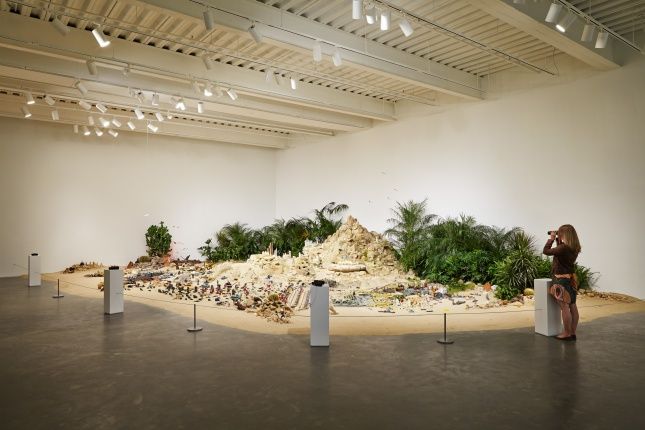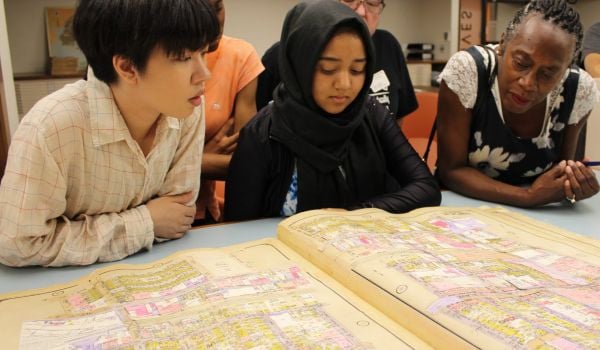Charles Dickens is trending in New York City this fall. While Bill de Blasio was completing his meteoric ascent to Democratic mayoral candidate on his “Tale of Two Cities” platform, curators at the New Museum were preparing to install two tons of sand and 5,000-plus toys and model pieces of a 1981 Chris Burden art installation named after Dickens’ famous account of the best and worst times.
The installation, which at first seems unrelated to de Blasio’s message of economic disparity, depicts one miniature city-state sending arms-wielding robots into an outmatched foreign counterpart’s territory. Museum curators present the work as a glorified “child’s war game,” emphasizing the “complexity, obsession, and absurdity” of Burden’s detail-oriented creation.
But the devil isn’t always in the details. Put down the binoculars that allow for an up-close look at the toy-scale landscape, and one notices something curious when surveying the work as a whole. Atop the mountain range dividing the two cities stands an assortment of miniature mansions, among them a scale replica of “Fairytale King” Ludwig II’s famously kitsch Neuschwanstein Castle. It is unclear where the residents of these tony suburbs fit into the conflict at hand. Searching for signs of life at the other end of the socioeconomic hierarchy, one comes across a slum clustered beside a landfill not far from the larger town’s airport.
Suddenly, one tale of two cities seems like a mask for another story, one closer to that which de Blasio told this election season. The entire work begins to feel like an allegory about the spectacle of power as a smokescreen for economic divergence. This is prescient for 1981, when the escalation of Cold War-era patriotic sentiment coincided with the implementation of what some have argued was a systematic program for creating wealth inequality.
Of course the work’s curatorial framing does not encourage this line of thought, which, given the New Museum’s immediate urban context, might lead to an unflattering parallel. In 2007, the contemporary art museum moved from Chelsea to a stretch of the shabby-chic Bowery on the Lower East Side, an area where trendy bars and restaurant supply shops mixed with halfway houses that had been there for generations.
In the story that has come to define the Bowery following its transformation from Skid Row into what has at times literally resembled an art world playpen, the New Museum is a cross between a weapon of mass distraction and a fairytale palace. Chris Burden: Extreme Measures is its most ambitious retrospective to date. Like the Bowery today, it is a testament to gentrification. The museum, however, is not entirely to blame for this.
Burden is an artist who, like legendary Bowery punk rock and New Wave club CBGB, came of age in the 1970s. His early work frequently assumed the form of protest-like acts of self-mutilation. In works such as Trans-fixed (1974), in which he had himself crucified on the back of a Volkswagen, and Shoot (1971), which consists of the artist being shot by a .22-caliber rifle on camera, Burden offers himself up as a martyr to critical consciousness. Vicarious sensation, in these works, is positioned as a counter-ideological weapon against the insidious appeal of commercial objects and instruments of power.
The large-scale object-based works produced by the artist thereafter still have considerable sensorial impact. Many of them, however, risk cultivating the same enthrallment his earlier works seemed so effective at undermining.
Take, for example, The Big Wheel (1979), one of Burden’s first sculptural creations. The work features a motorcycle mounted in front of a “three-ton, eight-foot diameter, cast-iron flywheel.” As with many of the artist’s sculptures, just reading the materials list out loud is enough to rev one’s proverbial engines. When the 250cc motorcycle is actually kick-started, positioned so that its rear tire abuts the cast-iron cylinder, and briefly accelerated to its top speed, the only congruous response is a manly growl of approval. At the press preview, the inaugural activation of the work drew a burst of giddy applause from those in attendance. If there was a message about the role symbols of individualism play in driving the big wheels of industry, it was drowned in ovation.
But then, perhaps, no message was forthcoming. In one of the self-penned commentaries to a series of scale model bridges constructed out of thousands of erector parts, Burden writes of being childishly “mesmerized” by feats of engineering. Staring at these bridges to nowhere, one begins to suspect that the New Museum’s scant attention to Burden’s early work, which initially seems an injustice, actually reflects its commitment to a representative depiction of the artist’s creative temperament. As one progresses through the show, Burden’s oeuvre seems less a disaffected response to American machismo than a catalogue of the numerous ways in which he himself has been fanatically transfixed by symbols of power.
Among the works contributing to this impression are an installation documenting every submarine ever produced by the U.S. military (a school of flying phalli), a pair of Namur Mortars and accompanying 12,000-pound cannonballs (who has the bigger cojones?), a meticulously restored 1964 Ford F350 crane truck with a one-tone cast iron weight suspended from it (“Built Ford Tough”), and a stack of 32-ounce gold bricks titled Tower of Power (1985), which can only be viewed under observation of an armed guard.
Collectively these works are like a bad parody of the political dead-endedness sometimes attributed to Foucauldian academics whose work compulsively reiterates the supposition that “power is everything.” Indeed, the trajectory of Chris Burden’s career — his shift from iconoclastic performer to monumental object-maker as well as, not insignificantly, from Ronald Feldman Fine Arts to Gagosian Gallery — is not a little like that of a once-radical professor who has since settled into the easy chair of tenure. Or an edgy neighborhood where art was made that has become a place to buy it.
















